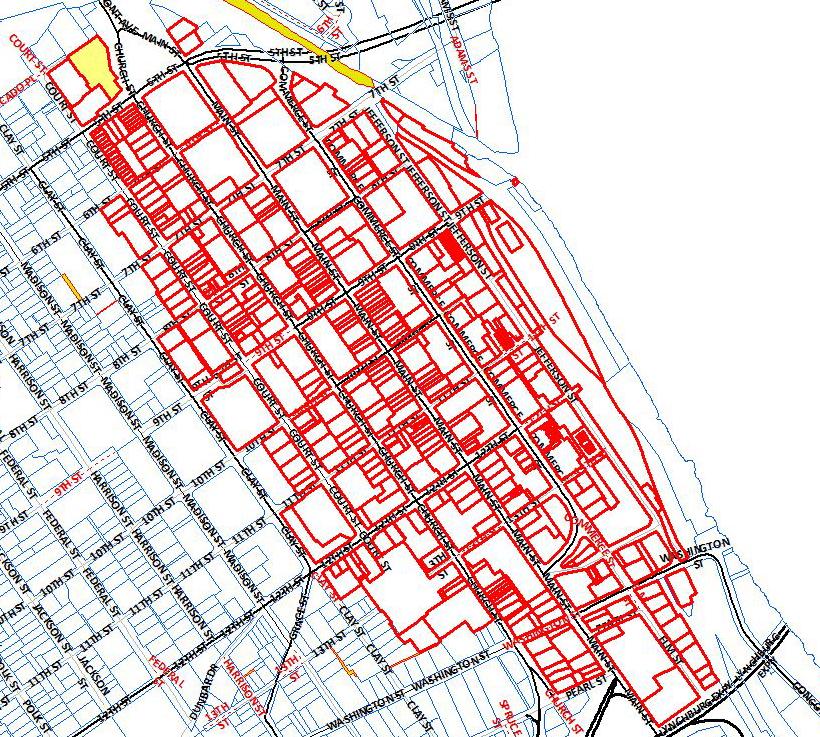D





The Strategic Plan 2022 Update for the Downtown Lynchburg Association (DLA) is intended to guide the organization’s evolution over the next five years and beyond. The plan was informed by input from DLA staff and Board of Directors, a Project Working Group, and City leadership; along with broad community feedback, current market trends, impacts from the Covid-19 pandemic, and best practices from comparable downtown markets.
DLA’s latest strategic plan was completed in early 2020. The timing was right for a 2022 update for two key reasons:
1. To adapt to a changing world impacted by the pandemic, and a changing Downtown Lynchburg that has experienced transformative public infrastructure investments.
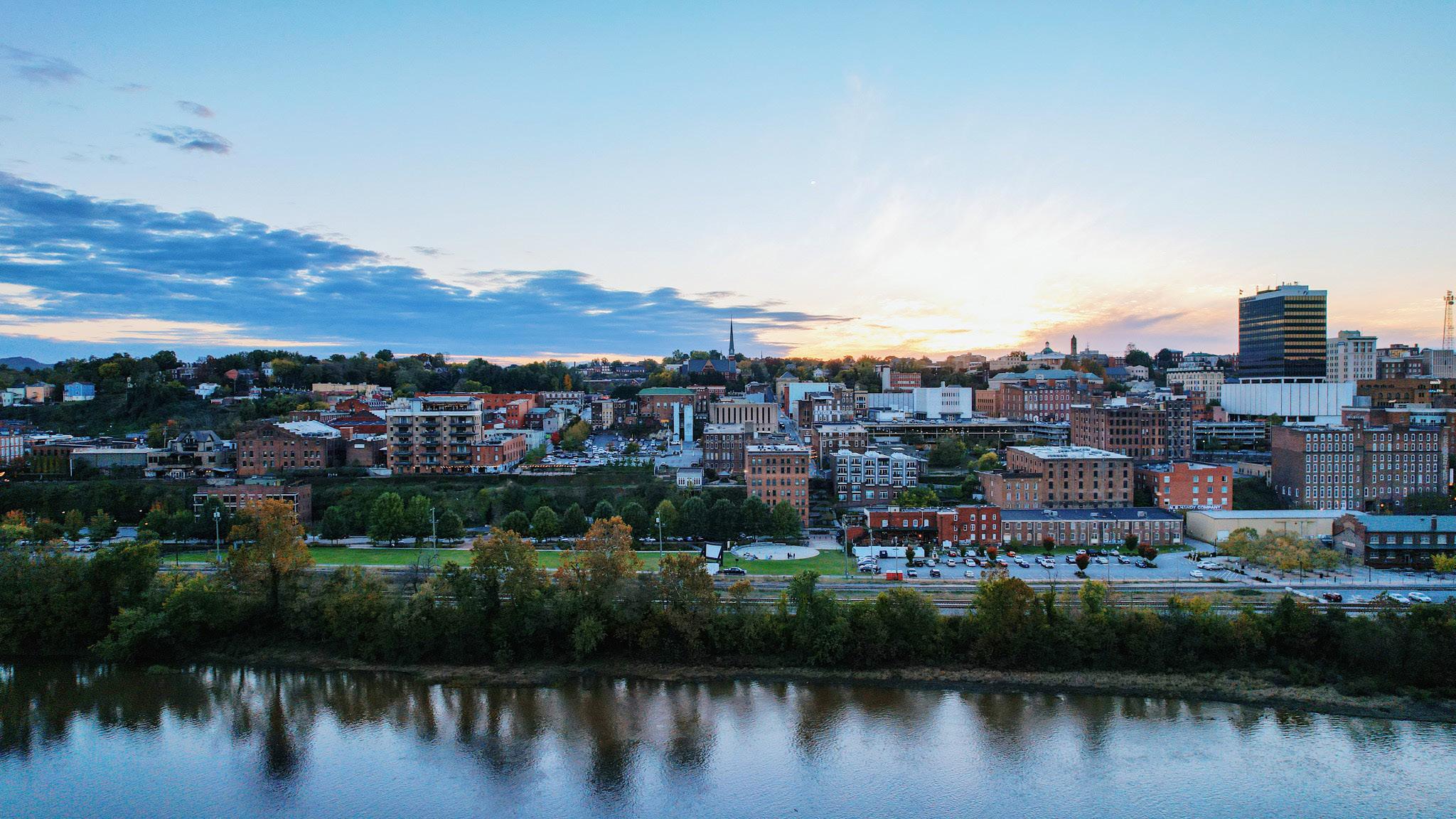
2. There was still a need for financial stability for the organization that the 2020 plan did not directly address.
About Downtown Lynchburg Association: DLA, a 501(c)(3) non-profit organization, has been working as the champion for downtown revitalization for 25 years. Throughout its history – as both Lynch’s Landing and Downtown Lynchburg Association – the organization has been a catalyst for positive growth. Lynch’s Landing was rebranded during a restructure in 2017 to Downtown Lynchburg Association.
To assist in the strategic planning process, DLA contracted with Progressive Urban Management Associates (P.U.M.A.), a real estate economics and planning firm specializing in strategic planning for downtown organizations.

An understanding of Downtown’s market dynamics helped to inform the strategic planning effort. Many of these insights were drawn from stakeholder interviews, as well as a review of past planning documents and site visit observations.
» The residential sector has been the driver of Downtown development over the last two decades. However, growth has been fairly one-dimensional, creating units predominately at high price points for the Lynchburg market. Downtown still lacks affordable and varied price points and housing types that would support a more diversified residential base.
» Indications are that demand for Downtown living remains strong and there’s room and desire to add more rooftops.

» The Covid-19 pandemic did not slow residential development momentum in Downtown as it did in many other downtowns throughout the country. The sector remains strong with several projects in the construction phase and development pipeline.
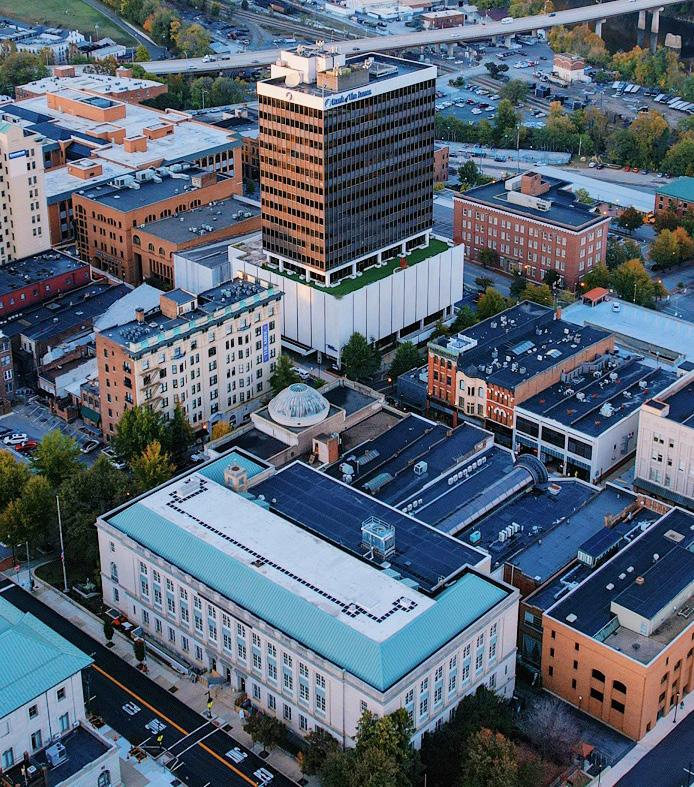
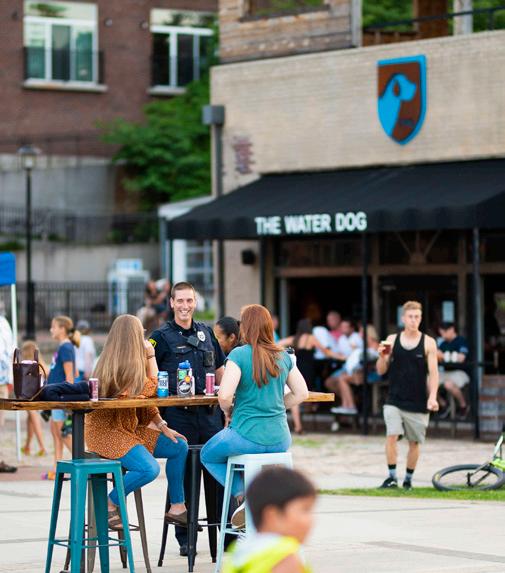
» Downtown retail is a mix of predominately local and regional, independent businesses, driven by the dining sector. This offers an authentic atmosphere that is a unique attraction within greater Lynchburg.
» There are still not enough households and residents in Downtown to sustain a retail footprint on their own. The larger citywide trade area and visitors are still needed to support existing retail and further growth.
» Vacant storefronts are prominent – Downtown’s current storefront vacancy rate is 25% – not to mention the presence of undeveloped properties and lots.
» There is room for more retail store variety. Some missing pieces include key amenities (such as a grocery, pharmacy, etc.), as well as varied entertainment options (nightlife, live music, etc.).
» In terms of recent growth and development, the office sector lags more than the others in Downtown.
» Furthermore, this is where there is the most uncertainty nationwide with regard to how the office sector will recover from Covid-19 impacts and adapt over the next decade to more hybrid work environments. Since Downtown Lynchburg is not as office-centric as many other downtowns nationally, it wasn’t hit as hard by the pandemic and resulting remote work boom over the past two years.
» With a smaller employment base, Downtown Lynchburg’s office sector and daytime worker population is reliant on a few key large tenants.
» Downtown has a modest visitor market and number of Downtown hotel rooms. The local universities drive a strong, consistent base of out-of-town visitors – some of which may stay Downtown; however, there is also a large number of hotel rooms around Liberty and further out in the region that pull many of the out-of-town guests.
» The region’s two higher-end boutique hotels are both located in Downtown. This is the type of concept that is Downtown’s strength, and accentuates the local and authentic appeal of the neighborhood.
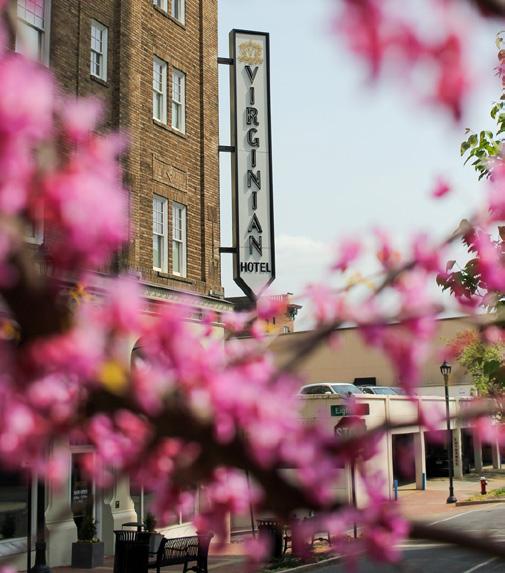

Through the strategic planning process, a variety of stakeholders were engaged, capturing a wide range of perspectives on Downtown Lynchburg’s strengths and challenges from City officials, property and business owners, employees, residents, and regular visitors to Downtown. Engagement took place in a number of different formats, including one-on-one interviews and roundtables, both virtually and in-person, as well as an online survey that collected over 500 responses.
Themes, regarding what the community wants to see in Downtown and from DLA, most-consistently heard from the community include:
» Support small businesses, fill vacant storefronts, and create a wider mix of retail, services, and entertainment options in Downtown
» More programming, events, and space activations
» Key property redevelopment of vacant and underutilized lots and buildings
» Some bigger public infrastructure projects and strategic initiatives consistently came up – namely, river and trail access, Riverfront Park and its future amenities (amphitheater, splash park, etc.), and a Downtown dog park
» A desire for more beautification, cleaning, and general maintenance of the public space throughout Downtown

In the online survey, which was open to anyone interested, respondents were asked to select a single action that will be most important to achieve their vision for Downtown. The top selections – with the top-three similar in that they are all economic developmentoriented actions – were:
#1 #2 #3 #4
More restaurants/retail/entertainment amenities
Redevelop and repurpose vacant buildings and lots
Provide support to small businesses and entrepreneurs
More events and festivals
In roundtables, participants helped brainstorm and prioritize roles for DLA over the next five years. Top priorities in this prioritization exercise were:
#1 #2 #3 #4
Events, programming, and space activations
Cleaning, maintenance, and beautification
Marketing, promotions, and storytelling
The word cloud is based on responses to the online survey that asked for three words to describe the vision for Downtown Lynchburg in the year 2030. The largest words were those used most often.
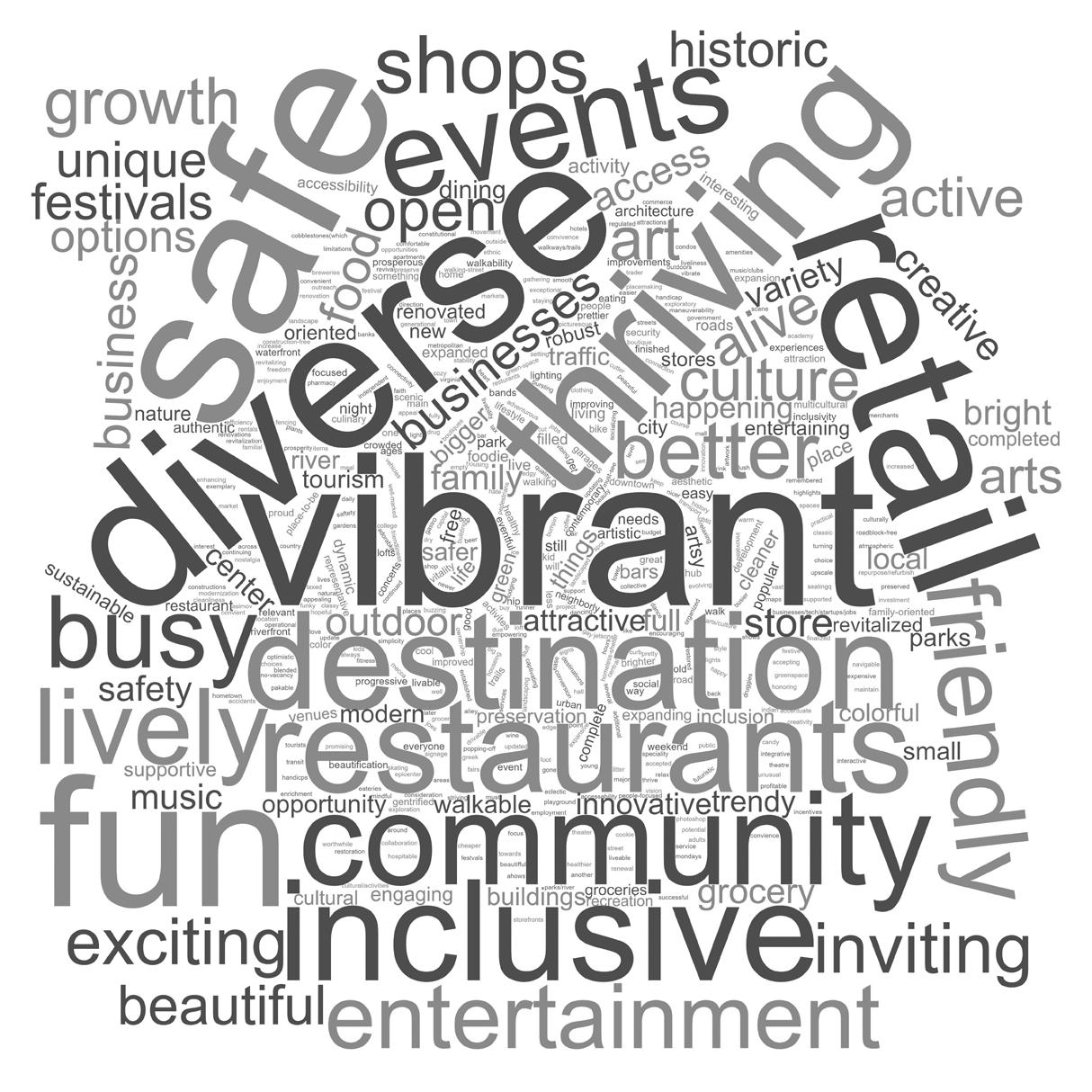
The 2022 Plan lays out four near-term goals for the next two years, and two longer-term goals that require additional funding for DLA prior to undertaking. Within each goal, objectives are identified.
A. Activate vacant storefronts in Downtown.
B. Provide ongoing support and advocacy for existing storefront businesses.
C. Work with businesses to help mitigate impacts from ongoing construction work.
D. Proactively recruit diverse and targeted businesses to Downtown Lynchburg based on recommended retail mix outlined in the 2021 Retail Positioning and Tenanting Strategy
E. Advocate for the exploration and potential adoption of the recommended City efforts outlined in the 2021 Retail Positioning and Tenanting Strategy
F. Collect, maintain, and disseminate key Downtown market data.
G. Incorporate the Fifth Street business corridor into DLA’s new suite of storefront business support services.
A. Elevate and promote Downtown businesses and events.

B. Maintain and grow a digital presence and the DLA brand.
C. Integrate storytelling that celebrates and promotes Downtown Lynchburg and its local merchants and small businesses.
D. Incorporate Fifth Street businesses into DLA’s marketing and promotions efforts.
A. Enliven public spaces through placemaking (with projects like Art Alley).
B. Animate Downtown public spaces through small-scale and/or temporary activations and programming.
C. Continue the production of a handful of signature events as capacity allows (i.e., Get Downtown, Fireworks, etc).
D. Curate and/or encourage other events and festivals that will bring people Downtown throughout the year.
E. Encourage, assist, and promote storefront businesses in their own programming and special events.
A. Maintain a strong relationship with the City of Lynchburg and other key partner organizations.
B. Elevate DLA’s profile and influence in the community.
C. Advocate for policies that are important to Downtown’s future and align with DLA’s mission.
D. Drive forward (or be a catalyst for) priority strategic initiatives and projects that DLA constituents want to see – such as trail and river access, Riverfront Park improvements, Bluffwalk enhancements, a dog park, etc.
LONGER-TERM GOALS (ADDITIONAL, SUSTAINABLE FUNDING NEEDED PRIOR TO UNDERTAKING)
A. Provide supplemental cleaning to ensure a highlevel of cleanliness in Downtown.
B. Incorporate beautification throughout Downtown, such as flower baskets, planters, banners, etc.
C. Provide temporary seasonal beautifications, such as holiday decorations.
D. Maintain, repair, and improve Downtown’s tree canopy.
E. Improve pedestrian lighting throughout Downtown, via both permanent and temporary or decorative offerings.
A. Encourage walking, biking, and transit to connect to Downtown from other parts of the community.
B. Work with partners to achieve better accessibility and walkability around Downtown.
C. Consolidate the management of all Downtown public parking under the DLA umbrella.
D. Coordinate and contract with private parking owners to better incorporate these lots into Downtown’s overall parking network.
E. Create a more consistent and visitor-friendly experience for paid parking options.
VISION:
Downtown Lynchburg Association works to bring the vision outlined in the Downtown 2040 Master Plan to realization.

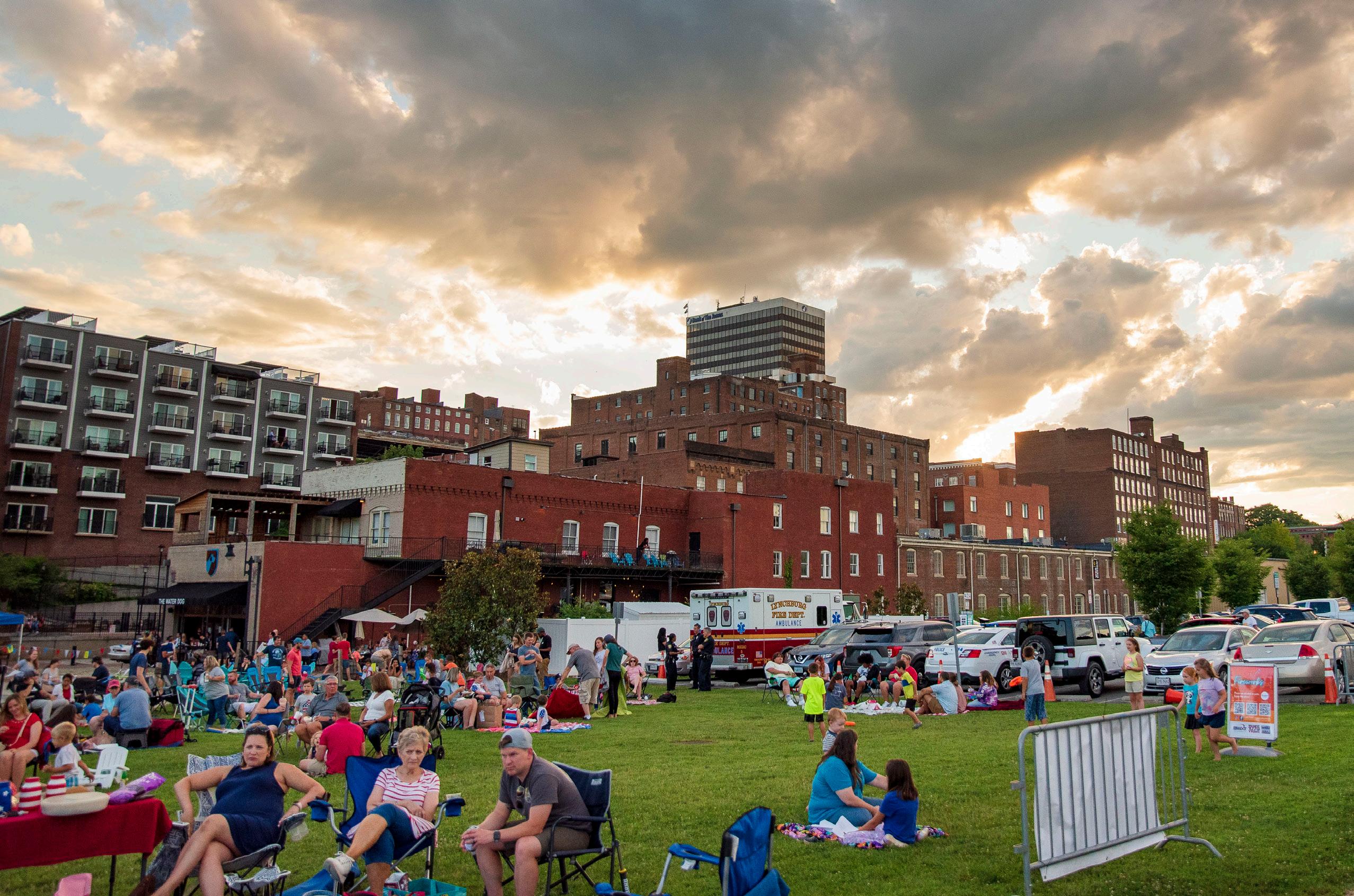
In 2040, Downtown Lynchburg will be a bustling and thriving urban core; the economic, social, and cultural hub of Central Virginia – a destination for visitors and a livable neighborhood for residents. Both locals and tourists alike will enjoy a diverse offering of retail, restaurants, and recreational activities set in a Downtown rich with historic architecture, unique topography and vibrant public spaces. This is the exciting atmosphere that makes Downtown Lynchburg the heart of the region.
MISSION:
To build a strong, vibrant, and welcoming downtown.
CORE VALUES:
1. Bring the energy. Passion for a strong, vibrant, and welcoming downtown.
2. Everyone is welcome. Dedication to inclusivity.
3. Do the right thing. Integrity and excellence in all that we do.
4. Be curious, flexible, innovative, and bold. Addressing the challenges and opportunities of the changing needs of our downtown.
5. Listen to evolve together. Collaboration for a stronger community.

NEAR-TERM GOALS (NEXT 2 YEARS)
A BID is a private sector funding mechanism designed to improve the environment of a business district with new services financed by a selfimposed and self-governed property assessment. If there is a strong desire to address Goal 5 (Clean and Green), additional funding will be required and a BID is an appropriate tool to fund this type of enhanced service in Downtown. The option of forming a BID in Downtown Lynchburg has been discussed and evaluated in the past. It is recommended that this tool be evaluated again, in light of Downtown’s continued development and growing demand for core services. Initial analysis indicates that a BID could create $200,000 or more in revenue for enhanced Downtown services.
If a BID is formed, it is possible to leverage assessment dollars with contracts for services. BIDs often take over contracts that the City operates within the district’s boundaries for services such as maintenance, beautification, tree care, etc. There is also opportunity for contracts with private property owners within the district boundaries.
Parking management is currently operated out of the City, without a dedicated authority or staff, and receives minimal attention beyond tracking financials. DLA used to manage Downtown parking. There has been an appetite recently for transitioning parking management back to DLA – and general agreement that parking is now big enough that it needs to live somewhere where it can get the proper attention it warrants. The ultimate goal should be to reactivate parking as a revenue source, dedicated program area, tool for economic development, and to view parking in general as part of the user experience in Downtown.
In particular, if a Downtown BID is formed (and under the assumption that DLA manages it), it is recommended that DLA should change its organizational structure from a non-profit that’s housed within the City of Lynchburg to an independent non-profit.


The Community Market is one of Downtown’s most popular attractions – and a differentiator when compared with the rest of the Lynchburg region. There’s an opportunity for it to be an even more impactful incubator to new businesses, giving entrepreneurs a space that offers a low-risk opportunity to test and prove their business’s viability. It is recommended that the City and DLA explore a potential transition of management to DLA in the longer-term.




Downtown Lynchburg Association (DLA), a 501(c)(3) non-profit organization, has been working as the champion for downtown revitalization for 25 years. Throughout its history – as both Lynch’s Landing and Downtown Lynchburg Association – the organization has been a catalyst for positive growth. Lynch’s Landing was rebranded during a restructure in 2017 to Downtown Lynchburg Association.
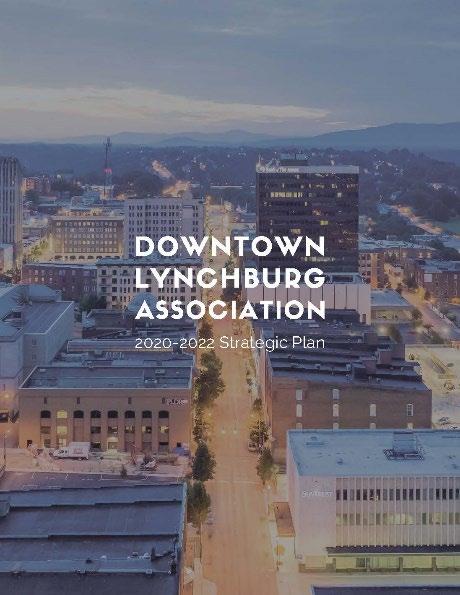
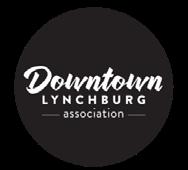
Downtown Lynchburg Association is an accredited program of the Virginia Main Street and the National Main Street Center™, as well as a member of the International Downtown Association (IDA). Working closely with the City of Lynchburg, DLA works to sustain and develop Downtown as a vital economic, cultural, recreational, residential, and historic center for the Lynchburg community. It does so through marketing initiatives, public space improvements, business engagement programs, cultural events, amongst other efforts.
DLA is currently operating under a three-year Strategic Plan that was established in early 2020.
DLA’s most recentStrategicPlanwas completedinearly2020,rightbefore the Covid-19pandemic
The timing is right for an update to DLA’s 2020-2022 Strategic Plan for two key reasons:
1. To adapt to a changing world and changing Downtown Lynchburg. The last planning process was conducted prior to the Covid-19 pandemic that has had a major impact on downtowns across the country since early 2020. Despite the pandemic, Downtown Lynchburg also continues to positively transform, with major public infrastructure projects underway as well as new private investments. This plan will consider post-Covid recovery and beyond, and respond to current and future market influences affecting downtown Lynchburg.
2. While the key goals of the 2020 strategic plan are sound and remain valid, there is still need for financial stability for the organization that the 2020 plan did not directly address As Downtown grows and demand for services increases, financial sustainability for DLA will be even more important. Establishing a roadmap to financial stability will be a key point of emphasis in this plan
To assist in the strategic planning process, DLA contracted with Progressive Urban Management Associates (P.U.M.A.), a Denver-based real estate economics and planning firm specializing in strategic planning for downtown organizations.
To advise the consultant team, and meet the goal of alignment and consensus among Downtown stakeholders, P.U.M.A. engaged a Project Working Group during strategic intervals of the planning process. The Working Group included DLA staff, board leadership, and City of Lynchburg representation.

The strategic planning process was comprised of three steps – an external assessment, an internal organizational assessment, and synthesis into a strategic plan.
1. An External Assessment informed the plan through discovery of stakeholder aspirations and market realities for Downtown Lynchburg. This included a review of relevant studies and reports, including the 2040 Downtown Master Plan and recently-completed MJB Downtown Market Study, as well as a variety of on-site and remote one-on-one interviews, small group roundtables, board workshops, and an online survey. Themes from stakeholder outreach are described in the next section.
2. An Internal Assessment reviewed DLA as an organization to evaluate any changes needed to be made in order to effectively address the challenges and opportunities identified for Downtown Lynchburg through the External Assessment. The primary point of emphasis in this step was to inform the development of a roadmap to financial stability for DLA, which has been a long-standing challenge for the organization. This step also looked at best practices from comparable downtown management organizations.
3. The final step, Plan Synthesis, took findings from the Internal and External Assessments and put them into a draft strategic plan framework with initial recommendations for DLA. This framework was presented to the Working Group, and feedback was incorporated into a final plan. The plan was finalized in June 2022.
The following snapshot of Downtown’s market dynamics helped to inform the strategic planning effort. Many of these insights were drawn from stakeholder interviews, as well as a review of past planning documents and site visit observations.
• The residential sector has been the driver of Downtown development over the last two decades However, growth has been fairly one-dimensional, creating units predominately at high price points for the Lynchburg market.
• Indications are that demand for Downtown living remains strong and there’s room and desire to add more rooftops
• The Covid-19 pandemic did not slow residential development momentum in Downtown as it did in many other downtowns throughout the country. The sector remains strong with several projects in the construction phase and development pipeline.
• Downtown still lacks affordable and varied price points and housing types that would support a more diversified residential base.
• Retail in Downtown is a mix of predominately local and regional, independent businesses, driven by the dining sector. This offers an authentic atmosphere that is a unique attraction within greater Lynchburg.

• There are still not enough households and residents in Downtown to sustain a retail footprint on their own. The larger citywide trade area and visitors are still needed to support existing retail and further growth
• Vacant storefronts are prominent – Downtown’s current storefront vacancy rate is 25% - not to mention the presence of undeveloped properties and lots.
• There is room for more retail store variety in the mix – it’s still an incomplete retail environment. Some missing pieces include key amenities (such as a grocery, pharmacy, etc.), as well as varied entertainment options (nightlife, live music, etc.).
• From DLA’s 2021RetailPositioningandTenantingStrategy , Downtown’s retail mix should lead with – (1) distinctive dining concepts, (2) craft beer, and (3) other forms of diversified entertainment such as live music, gaming, paint-and-sip, etc.
• The Community Market (and perhaps other spaces) presents itself as an opportunity for entrepreneurs to test their ideas and concepts – something that should be encouraged and a way for Downtown to further differentiate itself from more traditional (and/or stale) retail environments in the community.
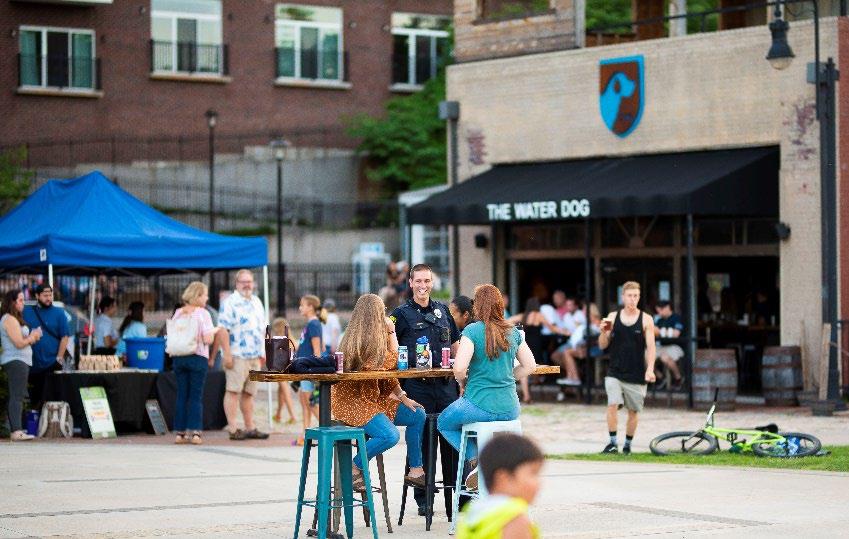
• In terms of recent growth and development, the office sector lags more than the others in Downtown.
• Furthermore, this is where there is the most uncertainty nationwide with regard to how the office sector will recover from Covid-19 impacts and adapt over the next decade to more hybrid work environments. Since Downtown Lynchburg is not as office-centric as many other downtowns nationally, it wasn’t hit as hard by the pandemic and resulting remote work boom over the past two years.
• With a smaller employment base, Downtown Lynchburg’s office sector and daytime worker population is reliant on a few key large tenants (namely, Pacific Life) and whether they return to the office postpandemic.


• Downtown has a modest visitor market and number of Downtown hotel rooms. The local universities drive a strong, consistent base of out-of-town visitors – some of which may stay Downtown; however, there is also a large number of hotel rooms around Liberty and further out in the region that pull many of the out-of-town guests.
• The region’s two higher-end boutique hotels are both located in Downtown. This is the type of concept that is Downtown’s strength, and accentuates the local and authentic appeal of the neighborhood
• There is also an Airbnb presence in Downtown. This is a doubleedged sword, both bringing visitors who support Downtown retail, restaurants, and entertainment venues, but also siphoning away from Downtown’s full-time residential base.
Through the strategic planning process, a variety of stakeholders were engaged, capturing a wide range of perspectives on Downtown Lynchburg’s strengths and challenges from City officials, property and business owners, employees, residents, and regular visitors to Downtown. Engagement took place in a number of different formats, including one-on-one interviews and roundtables, both virtually and in-person, as well as an online survey The online survey collected over 500 responses. Roundtables were grouped according to DLA’s existing three external goals and conducted during a consultant team site visit in late October of 2021.
ThefollowingthemeswereheardfromstakeholdersaboutDowntownLynchburg’sstrengths,challenges,and ideasforimprovement.
Strengths
• Lynchburg is a very old city –Downtown has amazing historic character and charm.
• For a small city, Downtown punches above its weight – it feels larger when you’re in Downtown.
• The topography is a distinctive feature that adds to Downtown’s character (This is also a challenge, noted below.)
• Downtown has come a long way over the last 10-20 years, through both public and private investments
• Residential is Downtown’s anchor sector – there has been sustained strong residential growth with continued demand for Downtown living. Furthermore, this sector has not been impacted by Covid-19 at all.
• Downtown has experienced transformational infrastructure investments – i.e., the Bluffwalk, Water utilities, two-way conversions, and streetscapes.
• Higher education is a unique economic generator for a city of this size – there are multiple universities and colleges in a relatively-compact region.
• As a whole, Downtown Lynchburg hasn’t been economically hit as hard by Covid-19 as other downtowns nationally have been.
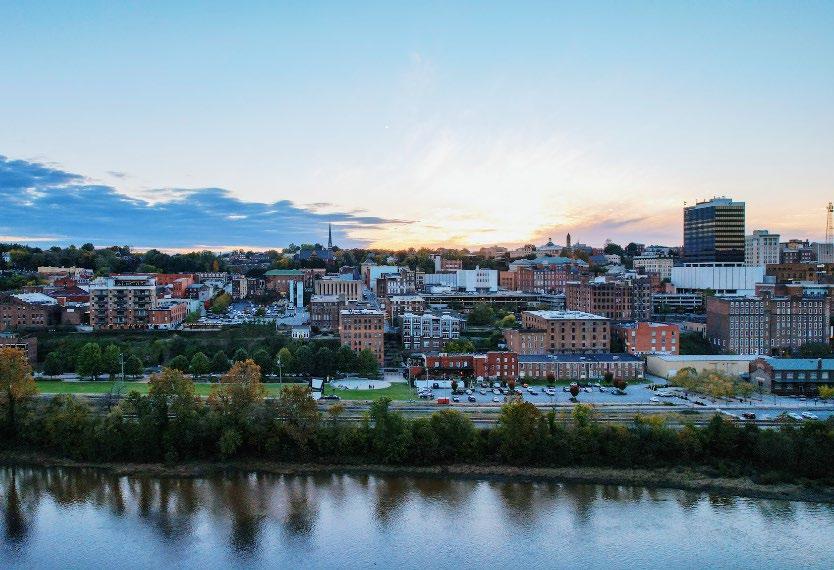

• Downtown’s walkability – it’s a compact, mixed-use neighborhood, and one of the most walkable parts of the region.
• There is a proximity to outdoor recreation and amenities, such as the James River and trail network
• The perception of Downtown from the greater Lynchburg community has been i mproving.
• The local, independent restaurants and merchants are a strength.
• Downtown has texture – it’s not all the same, it has different dimensions, and different streets have different atmospheres and character.
• The Farmer’s Market is a magnet and unique attraction.
Challenges
• There is concern about the mix of residential versus other uses – Downtown’s growth has been relatively one-dimensional
• The long-lasting construction and street and sidewalk closures from the Water/streetscape project is an ongoing challenge. There is exhaustion from construction, without a near-end in sight.
• Downtown still has a number of prominent properties that are poorly maintained and/or abandoned
• There are some growing nuisance and disruptive behaviors on the streets in Downtown.
• There is a lack of Class A office space – and now a lack of workers in the spaces that do exist, due to Covid-19 and remote work.
• Retail has struggled over last couple years – due to both Covid-19 and the disruption of the infrastructure project – resulting in a number of vacant storefronts (Downtown’s storefront vacancy is 25% as of the writing of this plan).
• The neighborhood is still missing key amenities (grocery, pharmacy, etc.) and lacks varied entertainment options (nightlife, music, etc.)
• Downtown lacks connectivity and synergy with the James River.
• In addition to being a strength, the topography also presents challenges – it hinders mobility, creates less of a desire to walk, raises demand on parking, and diminishes connectivity to the river and surrounding neighborhoods.
• There is a lack of cohesiveness across the Downtown footprint – there are long stretches between activated areas, and activity nodes are separated from each other.
• Downtown is still not as safe as people want it to be, especially when it comes to feelings of safety at night
• There remain some lingering negative perceptions from the community at-large – i.e., driving and parking Downtown is harder now, especially with all the construction; Downtown is “closed” on Sunday, Monday, and Tuesday; a lingering perception about lack of safety; too much money is being put Downtown as other parts of the city are being ignored

• There are infrastructure and basic services that could use improvement – namely, pedestrian lighting, signage and wayfinding, and trash collection
Improvements over the next five years
Thefollowingimprovementswerecommonlysuggestedbystakeholdersduringinterviews(notlistedinorderof importance).
• Incorporating more non-residential uses throughout Downtown
• Better parking management and coordination – to address Downtown’s growing parking problem
• Redevelop (or at a minimum, clean and maintain) the underutilized and vacant properties
• Better access and connectivity to the James River
• Additional placemaking efforts
• Better pedestrian lighting, to improve the sense of safety at night
• Create a university presence in Downtown
Roundtable participants went through a prioritization exercise, where they each were given four votes to help identity improvements that should be top priorities over the next five years. The table below shows top priorities.
Storefront Economy
Votesn/a – non-votingexercise;commonthemes:
• More varied housing options beyond high-end
• Activation/redevelopment of key properties
• More attractions and ‘magnets’ for visitors (like Amazement Square)
Lively & Engaging Atmosphere
1. Redeveloping and/or activating the empty buildings (8votes)
2. Services/amenities for residents (6votes) – grocery, pharmacy, laundromat, etc.
2. More retail (6votes)
2. General maintenance (6votes) – weeding, trash, etc.
Welcoming Environment
1. Better cleanliness and maintenance (10votes) – trash collection; more consistency and higher standards
2. Improve access to the river (8votes)
2. Grocery or convenience store (8votes)

Thefollowingthemeswereheardfromstakeholdersaboutthestrengths,challenges,andopportunitiesfor improvementwithinDLAasanorganization.
• DLA is small but effective in the roles it is able to take on – the organization, and its staff, do es a lot with a little.
• There is an ability to leverage from multiple sources.
• DLA has a positive relationship with the City of Lynchburg.
• DLA is a good liaison between businesses and the City of Lynchburg – it serves as an ear to the ground for the City
• It is very effective with marketing and communications, with a particularly strong social media presence.
• DLA is very strong at events and special programming; and really effective with small placemaking projects, such as Art Alley, temporary lighting, etc.
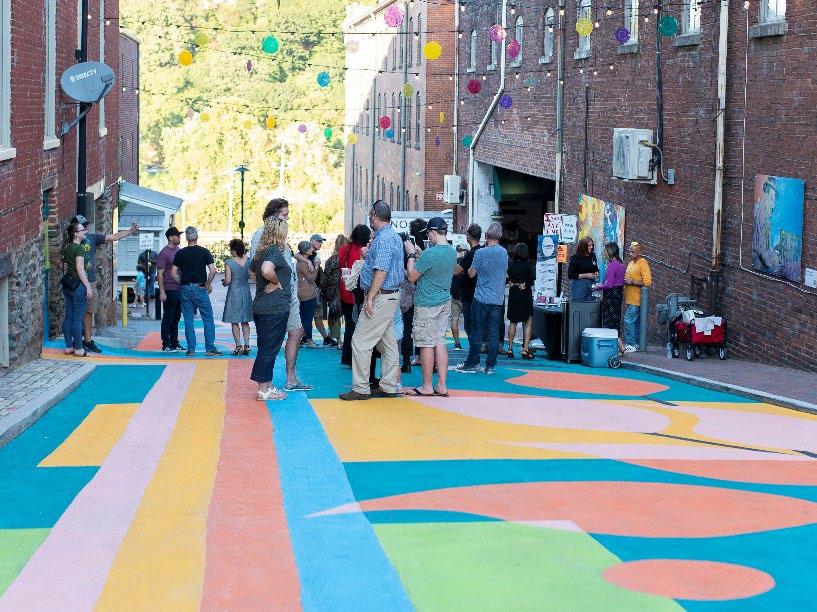
• There is a lack of clarity in what DLA is supposed to do
• A lack of resources and funding hinders what DLA is able to do, and limits how effective it can be.
• DLA is not empowered nor properly equipped to have a real significant role in economic development efforts – and there is confusion about who does what between the City, Chamber, and DLA when it comes to economic development in Downtown

• As a City employee, DLA’s Director is pulled in two directions, and can’t fully be a true advocate for Downtown property owners, businesses, and residents
Thefollowingimprovementswerecommonlysuggestedbystakeholdersduringinterviews(notlistedinorderof importance).
• More funding and resources; and more reliability of funding – but there is also a need to define what DLA needs the funding for
• Future service areas/needs for Downtown – supplemental cleaning, beautification (i.e., flower baskets, banners), wayfinding, more events and placemaking, parking management, construction mitigation and assistance
• Focus on things to “make Downtown a cool place”
• Establish a higher level of sophistication and capabilities with economic development thinking
• Be a bridge between individual property owners to help them work together
• There are pros and cons to the current DLA-City relationship – if goal is to separate from City into independent non-profit, it needs strong justification
• The idea of a BID (business improvement district) has merit, but – it could be tricky to sell politically; needs clarity on what it would do; and there is also the question of financials (“is the juice worth the squeeze?”)
Roundtable participants went through a similar prioritization exercise as they did for Downtown, where each attendee was given four votes to help identify the priority roles for DLA over the next five years. The table below shows top priorities.
Storefront Economy
1. Beautification and cleaning (10votes) – cigarettes, dog poop, flower baskets, banners, and general polish
2. Events (9votes) – e.g., Get Downtown
2. Tech upgrades/open Downtown wi-fi (9votes)
Lively & Engaging Atmosphere
1. Dedicated maintenance team (10votes) – beautification, flower baskets, etc.
2. Marketing and promotions (8votes) – newsletter, publicize what we have
3. Programming (6votes) – lead and coordinate
Welcoming Environment
1. Advocate for top priorities (10votes)
2. Maintain and improve digital presence – marketing and promotions (6votes)
3. Space activations (5votes)
3. Storytelling (5votes)
An online survey was broadly distributed to help identify priorities and improvements for DLA over the next five years. The survey ran in the fall of 2021, collecting 523 responses. Survey participants represented a cross-section of the Lynchburg community, including Downtown employees, property owners, business owners, and residents, as well as those who are regular visitors to Downtown. Participants were asked about both conditions in Downtown today and their vision for a future Downtown. A detailed, full survey summary can be found in the appendix.
The six most common words used to describe Downtown Lynchburg today were fun, restaurants, food, growing, historic, and construction.
When asked what characteristics have become better or worse in the past five years, all options scored favorably. The most improved characteristics were:
• General appearance (65% rated “much better”)
• Restaurants (65%)
• Arts and cultural activities and events (60%)
Overall, more than 50% of survey respondents rated various services in Downtown as either ‘very good’ or ‘good.’ The only exception was parking management, which still had positive, but more mixed results (46% very good/good, 28% fair, 14% poor/very poor).
The five most common words used to describe respondents’ vision for Downtown Lynchburg in the year 2030 were vibrant, safe, diverse, fun, and (more) retail (Word cloudtotherightillustratesfrequencyof variouswordssubmittedbyparticipants.)


When asked to choose the ONE action (from a list of 15) that will be most important to achieve their vision, the top choices – with the top-three being similar in that they’re all economic development-oriented actions –were:
1. More restaurants/retail/entertainment amenities
2. Redevelop and repurpose vacant buildings and lots
3. Provide support to small businesses and entrepreneurs
4. More events and festivals
Respondents were also given the chance to provide additional ideas for improvements to Downtown Lynchburg in an open-ended format. Ideas and common themes amongst responses, roughly ordered by frequency, included:
• Outdoor improvements – more green spaces, river access and trails, dog park, amphitheater, play areas, shaded areas, outdoor seating and dining, native plants, more trees, etc.
• Amenities for children – playground, water park/splash pad, family-centric retailers, etc.
• More unique retail and entertainment amenities – food hall, board game bar, etc.
• Signage and wayfinding improvements – including to amenities, destinations, and businesses, as well as for parking
• More affordable housing options
• Address the dog waste issue
• Bring more college students to Downtown
• Decorative lighting
• Pedestrianized streets – either temporary closures (i.e., on the weekend) or permanent
• More live music and concerts
As the above sections illustrate, outreach was conducted in a variety of settings, from in-person to virtual, and from one-on-one interviews to online surveys. Regarding what the community wants to see in Downtown and from DLA – themes from this outreach most-consistently heard across the board include:
1. Support small businesses, fill vacant storefronts, and create a wider mix of retail, services, and entertainment options in Downtown

2. More programming, events, and space activations
3. Key property redevelopment of vacant and underutilized lots and buildings
4. Some bigger public infrastructure projects and strategic initiatives consistently came up – namely, river and trail access, Riverfront Park and its future amenities (amphitheater, splash park, etc.), and a Downtown dog park
5. A desire for more beautification, cleaning, and general maintenance of the public space throughout Downtown
DLA is currently operating under a three-year Strategic Plan that was established in early 2020. The 2020 plan identified four core goals for the organization (below). This 2022 Update seeks to build from these goals, while adapting to changes of the last two years and the need for a longer-term evolution of the organization.
1. Foster a thriving and diverse storefront economy that supports Downtown Lynchburg’s business community, excites visitors, and meets the needs of residents

2. Cultivate a lively and engaging downtown atmosphere that identifies Downtown Lynchburg as a destination for locals and tourists alike
3. Create a truly welcoming environment that enhances the experience of Downtown Lynchburg’s visitors and residents
4. Increase DLA’s organizational effectiveness and ability to deliver on its mission now and in the future
The 2020 organizational goals remain a good foundation for DLA, and have served the organization well in guiding its role in Downtown Lynchburg during the last two years. The 2020 goals were organized as three “external,” operationally-focused goals (goals 1-3), and one internally-focused goal (goal 4). This Plan seeks to update and revise goals 1 through 3 – in order to more clearly tie to each of DLA’s program areas.
Goal 4 – since it is internally-focused – is more appropriate being incorporated into the implementation chapter of this plan. This is where the focus is placed on increasing DLA’s organizational effectiveness and ability to deliver on its mission and external goals.
Reshuffle priorities for DLA, based on the challenges of the past two years and stakeholder input
Within each goal, the objectives have been either rewritten or reorganized – to account for changes over the last two years and shifts in stakeholder priorities (in no small part, due to the tremendous disruption of the pandemic since the last plan was released)
Two longer-range goals are added – that are desired by the community, but also that DLA cannot feasibly lead without securing additional funding. If adequate, reliable funding can be established for DLA – which is explored in more depth in the implementation chapter – the organization will have the necessary resources to take on these additional program areas. To best account for current realities and longer-term ambitions, the 2022 goals are sorted into four near-term, and two longer-term, goals.
A refreshed vision, mission, and core values are provided below These updates align with what was heard during stakeholder outreach and synch with the updated goals and objectives provided in the following section.
VISION:
DowntownLynchburgAssociationworkstobringthevisionoutlinedintheDowntown2040MasterPlanto realization

In 2040, Downtown Lynchburg will be a bustling and thriving urban core; the economic, social, and cultural hub of Central Virginia – a destination for visitors and a livable neighborhood for residents. Both locals and tourists alike will enjoy a diverse offering of retail, restaurants, and recreational activities set in a Downtown rich with historic architecture, unique topography and vibrant public spaces. This is the exciting atmosphere that makes Downtown Lynchburg the heart of the region.
MISSION:
To build a strong, vibrant, and welcoming downtown.
1. Bring the energy. Passion for a strong, vibrant, and welcoming downtown.
2. Everyone is welcome. Dedication to inclusivity.
3. Do the right thing. Integrity and excellence in all that we do.
4. Be curious, flexible, innovative, and bold. Addressing the challenges and opportunities of the changing needs of our downtown.
5. Listen to evolve together. Collaboration for a stronger community.
The following section lays out four near -term goals for the next two years, and two longer-term goals that require additional funding prior to undertaking. Within each goal, objectives are identified. Tactics and specific programs within each goal are defined during DLA’s annual work planning process.
GOAL 1: Storefront Business Support – TOP NEAR-TERM PRIORITY
Rationale:Thestorefronteconomyhasexperiencedimmensechallengesoverthelasttwoyears.Downtown currentlyhasastorefrontvacancyof25%.Stakeholdershavenoticed,andapredominatethemeinoutreachwas the need to fill thesevacantspaces,createmoreretail , dining,and entertainmentoptions,andsupportsmall businesses.
A. Activate vacant storefronts in Downtown.
B. Provide ongoing support and advocacy for existing storefront businesses
C. Work with businesses to help mitigate impacts from ongoing construction work.
D. Proactively recruit diverse and targeted businesses to Downtown Lynchburg based on recommended retail mix outlined in the 2021RetailPositioning andTenantingStrategy

E. Advocate for the exploration and potential adoption of the recommended City efforts outlined in the 2021RetailPositioningand TenantingStrategy .
F. Collect, maintain, and disseminate key Downtown market data.
G. Incorporate the Fifth Street business corridor into DLA’s new suite of storefront business support services.
Support for small businesses and entrepreneurs is a priority nationally as the country works to mitigate the impacts of the pandemic on local economies. There are more federal, state, and non-profit resources for small business support arguably than there ever has been. DLA should be diligent in monitoring grant programs, that either directly or indirectly – could help support Downtown’s local storefront economy. Two state-level grant opportunities include:
• Virginia Main Street Financial Feasibility Grant: A program to allow Main Street communities to work with owners of significant “white elephant” buildings with nonproductive upper floor space. Grants of up to $25,000 are awarded to fund the development of preliminary design reports and renderings, building code and zone assessments, pro forma development and construction estimates, and other similar analyses.
• Virginia Community Business Launch (CBL) program: A program for local governments that offers training for entrepreneurs, creatives, and small businesses, in an effort to fill a critical mass of vacant storefronts with new ventures.
Rationale: Small-scaleactivations,specialprogramming,andeventsissomethingDLAhasalreadyproventobe adeptatleading.LikeGoal1,thisisanothertopicthatcamethroughconsistentlyasatoppriorityofstakeholders. Asonefocusgroupattendeestated,“focusonthingstomakeDowntownacoolplace.”Creativeactivations,
placemaking , andprogrammingareabigpartofthis . Placemaking andactivationscanalsobeviewedassymbioticwithGoal1 – an interestingandactivepublicrealmhelpsDowntownstorefronts thrive.
A. Enliven public spaces through placemaking (with projects like Art Alley).
B. Animate Downtown public spaces through small-scale and/or temporary activations and programming
C. Continue the production of a handful of signature events as capacity allows (i.e., Get Downtown, Fireworks, etc).
D. Curate and/or encourage other events and festivals that will bring people Downtown throughout the year
E. Encourage, assist, and promote storefront businesses in their own programming and special events
DLA should investigate and vet a Designated Outdoor Refreshment Area (ORA) license from the state of Virginia. This ABC license became available in July 2021 during the pandemic, allowing events to be run with an open container area within a certain perimeter. Many Virginia cities, large and small, have already pursued this license. This is an opportunity to help local restaurants and retail bring in additional revenue, supporting both Goals 1 and 2 in this plan.
Rationale:Marketingandpromotionshave evolvedintoastrengthofDLA’soverthelastseveralyears.Businesses andresidentsappreciatethisroleandskillsetthattheorganizationhas.DLAshouldcontinuetogrowitsstrength inthisrealm,withaparticularfocusonhelpingtoliftupDowntown’sstorefrontandsmallbusinesses.Successful marketingandpromotionswillhelpDLAbemosteffectiveinaccomplishingGoals1and2.
A. Elevate and promote Downtown businesses and events
B. Maintain and grow a digital presence and the DLA brand
C. Integrate storytelling that celebrates and promotes Downtown Lynchburg and its local merchants and small businesses.

D. Incorporate Fifth Street businesses into DLA’s marketing and promotions efforts.

Rationale:ItisimportantthatDLAincreaseitscommunity-buildingandadvocacyrole.Downtownischanging, majorprojects(publicandprivate)areunderwayorplanned,andDLAshouldhaveaseatatthetableforkey discussions and decision-makingrelatedtotheseefforts.
A. Maintain a strong relationship with the City of Lynchburg and other key partner organizations
B. Elevate DLA’s profile and influence in the community.
C. Advocate for policies that are important to Downtown’s future and align with DLA’s mission
D. Drive forward (or be a catalyst for) priority strategic initiatives and projects that DLA constituents want to see – such as trail and river access, Riverfront Park improvements, Bluffwalk enhancements, a dog park, etc.
Rationale:Maintainingaclean,safe,andattractivedowntownisfundamentaltosuccess.Nationally,many downtownorganizationsprovidesupplementalcleaningandbeautificationservicesaboveandbeyondtheCity’s baselevelofservicethatitprovides. While it did notrisetothelevelofotherprioritiesamongststakeholders, generalmaintenance,cleaning,beautificationdidregularlycomeupasadesireandareaforimprovementin Downtown.
A. Provide supplemental cleaning to ensure a high-level of cleanliness in Downtown
B. Incorporate beautification throughout Downtown, such as flower baskets, planters, banners, etc.
C. Provide temporary seasonal beautifications, such as holiday decorations.
D. Maintain, repair, and improve Downtown’s tree canopy.
E. Improve pedestrian lighting throughout Downtown, via both permanent and temporary or decorative offerings.
Ambassador Programs typically provide clean, safe, and green operations in many downtowns nationwide. (Photo courtesy of Golden Triangle BID)

Rationale: Stakeholders haveexpressedgrowingconcernaboutaDowntownparkingproblem.Parking – often the firstandlastthingmanyvisitorsexperiencein Downtown –iscriticaltohowpeopleevaluatetheirvisit.Parking managementiscurrentlyoperatedoutoftheCity,withoutadedicatedauthorityorstaff,andreceivesminimal attentionbeyondtrackingfinancials.TheresultisaDowntownparkingsystem that is uncoordinated – decks don’t alignwithon-streetparking(orprivatelots),streetparkingisfreeforalimitedtime,enforcementisinconsistent, etc. – creatinganenvironmentthatcanbefrustratingforvisitors.Beyondparking,Downtownhasthe bones and densitytobeLynchburg’smostwalkable,accessibleneighborhood.Thisstrengthshouldbebuiltuponto encouragewalkingandotherformsofnon-autotransportationtofurtherDowntown’svibrancy.
A. Encourage walking, biking, and transit to connect to Downtown from other parts of the community.
B. Work with partners to achieve better accessibility and walkability around Downtown.
C. Consolidate the management of all Downtown public parking under the DLA umbrella

D. Coordinate and contract with private parking owners to better incorporate these lots into Downtown’s overall parking network
E. Create a more consistent and visitor-friendly experience for paid parking options.
One of the chief desired outcomes of this strategic planning process was to find a pathway to a stronger and more sustainably-funded DLA. The following recommendations will help DLA most effectively achieve its new goals laid out in the prior chapter. Like the new organizational goals, the following recommendations are sequenced and listed in terms of priority via the same near-term (next two years) and longer-term (2+ years) bundles.

DLA is currently receiving approximately $150,000/annually in financial support from the City. (DLA receives $98,000 in-kind annually from the City of Lynchburg, for salary, rent, parking, event services, etc Additionally, in the near-term, DLA is receiving $108,000/year from the City to operate the Commerce Street construction communications contract. Roughly half of this contract, or $52,000, goes straight to DLA operations. Therefore, total support equates to $150,000 annually.)
It is recommended that the City contribution be increased by $100,000, to boost the to tal support from $150,000 to $250,000 per year for the next two years. Justification for this increase is to (1) prioritize economic recovery from the Covid-19 pandemic, and (2) recognize that Downtown is the economic engine of the city and region.
Priority uses for additional funding:
• Fortify DLA staff: Retention is an ongoing concern for DLA staffing at all levels. Staff is currently compensated at levels below those of industry peers on average and DLA’s support staff doesn’t receive any benefits at this time. Additional funding will allow the organization to elevate pay and/or establish benefits for all DLA positions Salaries should be commensurate with downtown management organization industry levels. These changes will help DLA attract and retain talent in a competitive economy
• Storefront support pilot program to jumpstart Downtown: Storefront business support is the top priority for DLA for the next two years (see Goal 1 in prior section), and staffing dedicated to this effort is needed. It is recommended that DLA hire a full-time businesssupportmanager to be a liaison, problemsolver, and connector between property owners and tenant prospects This position would also take on efforts related to the construction communications contract. The business support manager could be established as a near-term pilot position, to determine viability for position in the long-term.
• Programming funding: To most effectively deliver on DLA’s new near-term goals (1-4), funding for additional marketing, events, placemaking, promotions, and training is needed.
o Events – Signature event production is resource-heavy. To fully deliver on Goal 2, an event production subsidy would be needed. At minimum, City services for events (Police, EMS, etc ) should be provided in-kind.
o Placemaking – Art Alley has been very popular amongst the community. To create other interesting and creative spaces like this, funding support is needed .
DLA can, and should, continue to take advantage of its status as a 501(c)3 non-profit organization. Nationally, many downtown organizations utilize this type of status to maintain diverse revenue sources Non-profit c3 organizations remain an attractive investment for corporations, foundations, and individuals seeking to support results-oriented civic improvement causes (in particular due to tax write-off capability). Examples of project investments that have been driven by 501(c)3 organizations in other downtowns include public art and placemaking, and capital improvements ranging from landscaping to lighting.
In addition to a bolstered City investment, DLA should diversify its other revenue – by looking into securing additional grants, and monetizing its events through sponsorships and direct event income – while continuing to be impactful with its annual fundraising campaigns.
If there is a strong desire to address Goal 5 (Clean and Green) and Goal 6 (Mobility and Parking Management), additional funding is needed
A Business Improvement District (BID) is a private sector funding mechanism designed to improve the environment of a business district with new services financed by a self-imposed and self-governed property assessment. These services (such as cleaning and maintenance, greening, enhanced safety) are provided exclusively within the BID boundaries and are different from – rather than a replacement of – those already provided by the City of Lynchburg. BIDs are a common tool nationally. There are over 1,000 BIDs across North America, many concentrated in downtowns.
If there is a strong desire to address Goal 5 (Clean and Green), additional funding will be required and a BID is an appropriate tool to fund this type of enhanced service in Downtown. The option of forming a BID in Downtown Lynchburg has been discussed and evaluated before in the past. It is recommended that this tool be evaluated again, in light of Downtown’s continued development and growing demand for core services.
The following table provides basic modeling that illustrates different BID assessment rates and corresponding revenue potential. For this basic analysis, several assumptions were made, including:
• Commercial properties assessed based on property value, and residential properties assessed via flat annual rate. This is one of the more common models used nationally. (A full BID analysis would consider other options.)
• The commercial assessment rates illustrated in the table below are aligned with comparable downtown BID markets, which are also provided below. (Onthewhole,BIDassessmentstypicallyrangefrom5%to 10%ofunderlyingpropertytaxburdens.Lynchburg’soveralltaxburdenis$1.11per$100ofvalue.)
• Total taxable market value has been steadily increasing in Downtown Lynchburg. This would boost revenue potential further, assuming increases continue over the next several years.
• Lynchburg has a property tax rehab exemption as part of its property development incentive package. This may decrease revenue potential, although not dramatically.

• Fifth Street was not included in this analysis. Revenue potential would be boosted if Fifth Street properties are incorporated into the BID boundary.
Total
SUMMARY OF PROPERTIES
OTHER BID ASSESSMENT RATES (in Virginia/southeastern U.S.)
Roanoke $0.10 per $100 of AV
Rossyln $0.078 per $100 of AV
Norfolk $0.16 per $100 of AV
Knoxville $0.32 per $100 of AV
Durham $0.07 per $100 of AV
Louisville $0.0745 per $100 of AV
Nashville $0.1294 per $100 of AV
Columbia (SC) $0.1844 per $100 of AV
Chattanooga square footage/frontage
Middle range $0.07 to $0.20
The numbers above should be taken for what they are – ballpark estimates of BID revenue potential in Downtown Lynchburg. If there’s a desire to move forward with BID exploration, then a more in-depth and complete analysis will be required. For additional summary tables related to the above, and a map of parcels included, see the appendix.

If a BID is formed, it is possible to leverage assessment dollars with contracts for services. BIDs often take over contracts that the City operates within the district’s boundaries for services such as maintenance, beautification, tree care, etc. There is also opportunity for contracts with private property owners within the district boundaries. These types of contracts may focus on providing landscaping of private sector (or City) spaces to create more uniformed aesthetics within the downtown environment; or offering placemaking assistance to developers who are interested in creating spaces that would be open to the public. Examples of the latter may include creating concept plan for the space, selection of landscape elements that do best in downtown’s setting, or assisting with matching local artists for public art installations. Lastly, BIDs will sometimes negotiate contracts to provide services outside of the district’s boundaries, which usually focus on extending clean, safe, and green services to an adjacent area.
Parking – often the first and last thing many visitors experience in a downtown – is critical to how people evaluate their visit. Parking management is currently operated out of the City, without a dedicated authority or staff, and receives minimal attention beyond tracking financials. This was reflected in stakeholder outreach. Parking consistently came up as an area for improvement, and it was characterized as confusing and frustrating for users (and businesses).
DLA used to manage Downtown parking. There has been an appetite recently for transitioning parking management back to DLA – and general agreement that parking is now big enough that it needs to live somewhere where it can get the proper attention it warrants.
As it currently stands, parking is a net-loser. Furthermore, there are capital expenses that will be required in the next several years to update/replace infrastructure such as parking stations. In the near-term, as basic infrastructure is brought up to date, parking management should remain in the City. In the longer-term, once the basics are in order, DLA and the City should evaluate transitioning parking management back to DLA. The ultimate goal should be to reactivate parking as a revenue source, dedicated program area, tool for economic development, and to view parking in general as part of the user experience in Downtown.
There are examples around the country of downtown management organizations that successfully manage the parking in their districts. Doing so allows the parking system to be viewed holistically and from the business owner and user perspective, managed in a coordinated way, and treated as a key part of the larger downtown experience.
In particular, if a Downtown BID is formed (and under the assumption that DLA manages it), it is recommended that DLA should change its organizational structure from a non-profit that’s housed within the City of Lynchburg to an independent non-profit. This will align with best practices nationally and allow DLA to more effectively deliver services on behalf of BID ratepayers. The Executive Director position therefore would no longer b e a City employee. Based on financial implications of this change, this is not recommended until a BID is formed or other form of sustainable funding is secured

Community Market management: More evaluation needed
The Community Market is one of Downtown’s most popular attractions – and a differentiator when compared with the rest of the Lynchburg region. It also has potential to be an even more impactful incubator for new businesses and entrepreneurs. As stated in the 2021 MJB Market Study: “Early-stageentrepreneursmightnotbringmuch creditworthiness,buttheirpresence – mostlikelyinCityand/orDLA-sponsoredplatformsliketheCommunity Market – providesthesenseoffreshnessanddiscoverythatcanhelpDowntowntodifferentiateitselfvis-à-vis the offeringsandexperienceinmoreconventionalsuburbancenters.”
While an attraction and anchor for Downtown, there remains untapped potential with the Market. There’s an opportunity for it to be an even more impactful incubator to new businesses, giving entrepreneurs a space that offers a low-risk opportunity to test and prove their business’s viability.
The Market is currently managed by the City’s Parks and Recreation Department. It is recommended that the City and DLA explore a potential transition of management to DLA (detailed budget implications are unknown, and should be evaluated in more detail). There are examples of downtown organization-managed markets that can serve as guidance, case studies, and proof of concept – City Market in Roanoke and Selden Market in Norfolk are two Virginia examples (for more details, see profiles of these examples on the following page).
There are benefits to this change for the Market itself, Downtown, and DLA: (1) it creates a nimbler management model, giving the Market the chance to evolve at the rate it needs to; (2) there are possible ways to monetize the Market, such as integrating a food hall-component, commissary kitchen, event rentals, etc.; and (3) the above lead to a more vibrant attraction anchoring Downtown. Lastly, the timing may be right for further exploration of this transition as the Market gets ready to move forward with renovations (and adjacent streetscape work is completed).
Roanoke’s historic City Market (popularly known as the Farmer’s Market) is managed by Downtown Roanoke Inc., the local downtown management non-profit that is DLA’s counterpart, through a contract with the City. DRI has a Farmers Market Manager as a part of its staff.
The City Market has been an attraction in the heart of Downtown Roanoke since 1882, evolving over the years into a successful operation with approximately 40 market vendors that offer locally grown produce, flowers, plants, meats, cheeses, baked goods, and other crafted items. It’s open year-round, seven days a week.
Separately managed but functioning in synergy with the City Market as a part of the same experience, is the City Market Building. Seven local restaurants are located in the building with shared indoor and outdoor space for dining, as well as shopping and a space for events rental.
For various reasons, City Market is a good comparable, best practice that DLA and the City of Lynchburg should explore further as it evaluates new models for the Community Market’s management.

A different type of marketplace that could also serve as an inspirational best practice model for Downtown Lynchburg is Norfolk’s Selden Market. Located within the historic Selden Arcade, the Downtown Norfolk Council (DLA counterpart) operates the market with low rent and short-term (6 months) lease options, giving entrepreneurs a low-risk opportunity to test and grow new ideas. It has spaces for 11 vendors in “storefront” spaces, plus several regular pop-up booths. Vendors are both retail and food-based operators. The Market provides the space, mentorship, and dedicated resources for vendors. The Market also provides a variety of special events on a regular basis.
While different from Lynchburg’s current Community Market, Selden Market offers an alternative model for a downtown market that has been a local success and emphasizes retail incubation.
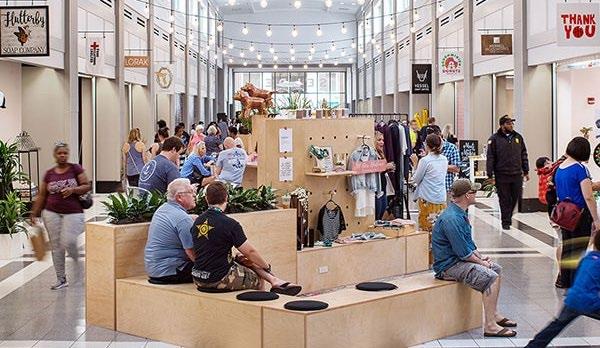
Below are suggested benchmarks for monitoring the success of the near-term Strategic Plan goals and objectives. DLA should select from, and adapt, the below as needed and based on data availability. Some metrics are more internal-facing, while others are worthy of reporting out to the community on a regular basis.
GOAL 1: STOREFRONT BUSINESS SUPPORT
• Key indicators for Downtown retail real estate – total square footage, number of storefronts, absorption, vacancies, rental rates, sales
• Storefront occupancy rate and inventory by business type (and ownership type – local vs. non-local)
• Number of openings and closings by year
• Number of DLA-led promotions for Downtown businesses

• Number of temporary storefront activations
• Dollars utilized/leveraged for storefront support (i.e., grant/loan programs)
• DLA touchpoints with Downtown businesses – number of onsite visits by DLA staff to businesses, percent of businesses visited per year, new business introductory visits, etc.
• Number of market data requests fulfilled
GOAL 2: PLACEMAKING, ACTIVATIONS, AND PROGRAMMING
• Major Downtown events (both DLA and other producers) –count and attendance rates
• Count of placemaking activations and small-scale programming
• Count of public art installations – permanent and temporary
GOAL 3: MARKETING, PROMOTIONS, AND BRANDING
• Social media following and engagement statistics
• Number of recipients of DLA communications and open rate
• Web vanity statistics
• Gift card and merchandise statistics
GOAL 4: ADVOCACY
• Downtown activity metrics – i.e., pedestrian, bike, and auto counts
• Total number of Downtown primary jobs
• Total number of Downtown residents
• Number of minority-owned businesses
• Downtown perception survey results
• Annual visitor/event attendance numbers
A. Survey Summary
B. Analysis of BID Revenue Potential

This online survey was developed to help identify priorities and improvements for Downtown Lynchburg Association (DLA) over the next five years, and will inform the 2022 DLA Strategic Plan Update. The survey ran from November 12 – December 5, 2021, and collected 523 responses. The following analysis presents a summary of Key Findings, followed by a more detailed question-by-question summary of results.

Respondent Characteristics and Demographics: The survey was open to anyone interested, and participants represented a cross-section of Lynchburg residents. Respondents were well-distributed by age and income, but less so by ethnicity/race. The most common residential zip code of respondents was 24503 (northwest of Downtown). Three-quarters of respondents identified as a regular visitor to Downtown, while 15% were Downtown residents, and 14% were Downtown employees.
When asked how often they have been in Downtown over the last year, 40% answered ‘once a week or more,’ while 24% said ‘every day.’ As reason for optimism as the pandemic and health conditions normalize, 57% of respondents said they’ll visit Downtown more than they have been, while virtually none said they’d visit less frequently (<1%).
Downtown Lynchburg Today
• The six most common words used to describe Downtown Lynchburg today were fun, restaurants, food, growing, historic, and construction
• When asked what characteristics have become better or worse in the past five years, all options scored favorably. The most improved characteristics were:
o General appearance (65% rated “much better”)
o Restaurants (65%)
o Arts and cultural activities and events (60%)
• Overall, more than 50% of survey respondents rated various services in Downtown as either ‘very good’ or ‘good.’ The only exception was parking management, which still had positive, but more mixed results (46% very good/good, 28% fair, 14% poor/very poor).
• The five most common words used to describe respondents’ vision for Downtown Lynchburg in the year 2030 were vibrant, safe, diverse, fun, and (more) retail.
• When asked to rate the level of importance of various actions that could help achieve the vision for Downtown, a majority of respondents rated most of the actions provided as ‘very important.’ At the top of the list, all with at least 60% of respondents saying they’re very important, were:
1. Redevelop and repurpose vacant buildings and lots (80% rated ‘very important’)
2. Provide support to small businesses and entrepreneurs (65%)
3. Ensure Downtown is diverse and welcoming to all (65%)
4. More events and festivals (63%)
• When asked to choose the ONE action (from the list of 15) that will be most important to achieve their vision, the top choices – with the top-three being similar in that they’re all economic developmentoriented actions – were:
1. More restaurants/retail/entertainment amenities
2. Redevelop and repurpose vacant buildings and lots
3. Provide support to small businesses and entrepreneurs
4. More events and festivals
• Respondents were also given the chance to provide additional ideas for improvements to Downtown Lynchburg in an open-ended format. Ideas and common themes amongst responses, roughly ordered by frequency, included:

o Outdoor improvements – more green spaces, river access and trails, dog park, amphitheater, play areas, shaded areas, outdoor seating and dining, native plants, more trees, etc.
o Amenities for children – playground, water park/splash pad, family-centric retailers, etc.
o More unique retail/entertainment amenities – food hall, board game bar, etc.
o Signage and wayfinding improvements – including to amenities/destinations/businesses as well as for parking
o More affordable housing options
o Address the dog waste issue
o Bring more college students to Downtown
o Decorative lighting
o Pedestrianized streets – either temporary closures (i.e., on the weekend) or permanent
o More live music and concerts
The word cloud below represents the words respondents used to describe Downtown today. The size of the word indicates how frequently it was used, with the largest words being the ones used most often. The top responses, in order, were fun, restaurants, food, growing, historic, and construction

Respondents predominantly feel the following characteristics have become better in the last five years. The three characteristics that scored highest, all with over 90% of respondents saying they became ‘much better’ or ‘slightly better’ in the past five years, were general appearance, restaurants, and arts and cultural activities and events. Even parking, which had the least consensus amongst respondents, had 49% state it has become ‘much better’ or ‘slightly better’ over the last five years (compared to only 20% who said it has gotten ‘slightly worse’ or ‘much worse’).

General appearance, incl. landscaping & beautification
Restaurants
Arts and cultural activities and events
Housing options
Cleanliness
Diversity and inclusivity
Businesses and jobs
Tourism and visitor activity
Pedestrian/bike safety Parking Much

For every service listed below, the most common rating amongst respondents was ‘good.’ Landscaping and tree maintenance was rated highest by respondents. Similar to results from the prior question, parking management had the least consensus amongst respondents; that said, only 14% rated the service as ‘poor’ or ‘very poor.’
Business Support
Signage and Wayfinding
Sidewalk and Stairwell Cleaning
Trash Removal
Pedestrian Lighting
Looking to the future, please offer three words that best capture your vision for Downtown Lynchburg by the year 2030.
The word cloud below represents the words respondents used to describe their vision of Downtown in the future. The size of the word indicates how frequently it was used, with the largest words being the ones used most often. The top responses, in order, were vibrant, safe, diverse, fun, and (more) retail

To achieve your vision for Downtown Lynchburg, which of the following actions will be important?

Respondents were asked to rate a series of actions by level of importance. The chart below is sorted according to the action’s importance, with the most popular answer choice highlighted in gray for each. On the whole, for most of the actions, the majority of respondents rated as ‘very important.’ The top four rated actions, all with at least 60% rating them as ‘very important,’ were:
1. Redevelop and repurpose vacant buildings and lots (80% rated ‘very important’)
2. Provide support to small businesses and entrepreneurs (65%)
3. Ensure Downtown is diverse and welcoming to all (65%)
4. More events and festivals (63%)
On the other end, respondents were most divided about the importance of more housing and residents, with 33% rating as ‘somewhat important.
Responses that were mentioned in the ‘Other’ open-ended response box included:
• Improvements to the Community Market
• Better access to the river
• Better ADA accessibility and compliance from businesses
• Housing options available at varied price points, not just high-end units
• Improved walkability and pedestrian safety
• Family-friendly amenities
To achieve your vision for Downtown Lynchburg, which one action from the prior question is the MOST important?

To further assist in identifying priorities, respondents were asked to select ONE action from the previous question’s answer choices that is most important. Results are shown in the chart below. (Given the number of answer choices, any that received more than 7% captured more than its ‘fair share’ of votes.)
“More restaurants/retail/entertainment amenities” was the top vote recipient – a variation from the above results, where this option wasn’t in the top-five choices. The second choice, by a clear margin, was “redevelop and
repurpose vacant buildings and lots.” The top-three choices below are all similar in the fact that they’re all economic development-based actions.
More restaurant/retail/entertainment amenities
Redevelop and repurpose vacant buildings and lots
Provide support to small businesses & entrepreneurs
More events and festivals
More outdoor amenities (e.g., playground, dog park)
Ensure Downtown is diverse and welcoming to all
More businesses and jobs
Improve safety
Improve the parking experience
More beautification (e.g., greening, flower baskets, lighting)
Enhance marketing of Downtown
More housing and residents
Improve cleanliness and maintenance
Create a safer walking and bicycling environment
More public art and space activations (such as Art Alley)
If you could suggest one additional and specific improvement to enhance Downtown Lynchburg, not listed above, what would it be?

Respondents were asked to provide ideas for additional improvements to Downtown Lynchburg in an openended format. More than half of survey participants provided an answer, with many simply elaborating on and emphasizing answer choices that were provided above. Ideas and common themes amongst comments included:
• Outdoor improvements – more green spaces, river access and trails, dog park, amphitheater, play areas, shaded areas, outdoor seating and dining, native plants, more trees, etc.
• Amenities for children – playground, water park/splash pad, family-centric retailers, etc.
• More unique retail/entertainment amenities – food hall, board game bar, etc.
• Signage and wayfinding improvements – including to amenities/destinations/businesses as well as for parking
• More affordable housing options
• Address the dog waste issue
• Bring more college students to Downtown
• Decorative lighting
• Pedestrianized streets – either temporary closures (i.e., on the weekend) or permanent
• More live music and concerts
Which of the following BEST characterizes your primary interest(s) in Downtown Lynchburg? (Choose all that apply)
During the past year, approximately how often have you been in Downtown Lynchburg?
As we move beyond the Covid-19 pandemic and health conditions normalize, do you think you’ll visit Downtown more, the same, or less frequently than during the past year?

Which of the following best describes you? (optional)

Survey respondents provides 34 different home zip codes. The zip codes with the most representation in the survey data include (in order of frequency):
1. 24503 (northwest of Downtown): 29% of respondents
2. 24502 (southwest of Downtown): 20%
3. 24504 (includes Downtown Lynchburg): 15%
Together, these make up 64% of responses.
The survey results were cross-tabulated to see if responses different based on respondent characteristics and demographics, including interest in Downtown, age, and income. There was not enough variation in the race/ethnicity of respondents to adequately compare results, so this category is not included below.
Similarities and contrasts between different respondents can most clearly be seen in the results to Q6 (i.e., the “which one action is MOST important?” question). Results to Q6, analyzed by various characteristics, are provided below. In the following tables, the top-three responses for each category are highlighted in yellow, helping to show similarities and differences in priority actions.

The table below shows some variation in the priority actions, based on what the respondent’s interest is in Downtown Lynchburg. Some key differences include:
• “Redevelop and repurpose vacant buildings and lots” was popular across the board, a top-three selection amongst all groups, and the top choice amongst most.
• There was some disagreement on “more restaurant/retail/entertainment amenities.” This choice didn’t garner much interest from Downtown business owners. Instead, they placed higher priority on “more businesses and jobs” than other interest groups.
• Intuitively, property and business owners placed the highest priority on “provide support to small businesses and entrepreneurs.”
• Downtown residents placed greater emphasis on “more events and festivals” than other respondent types.

• Students placed greater emphasis on “ensure Downtown is diverse and welcoming to all” and “improve safety.”
The age categories provided in the survey were under 18, 18 to 24, 25 to 34, 35 to 49, 50 to 64, and Over 65. The under-18 category had lower response rates so was combined with the 18-24 category, as the table below shows. Variations (and similarities) across age groups include:
• “More restaurant/retail/entertainment amenities” and “redevelop and repurpose vacant buildings and lots” were widely popular priorities across all age groups.
• “Improve the parking experience” directly correlated with age – the older the respondent, the more likely they were to select this as the top priority.
• “More outdoor amenities” was more popular amongst those under 50, vs. over 50; particularly in the 25 to 34 age group.
• “More festivals and events” was a higher priority for those under 25, compared to other groups.
• The over-65 age group was an outlier when it came to “enhance marketing of Downtown” – nearly all votes for this action came from this age group. To a lesser extent, the same is true for “more beautification.”
The income categories provided in the survey were less than $25,000, $25,000-$49,999, $50,000-$99,999, $100,000-$199,999, and $200,000 or more. Some of the age categories had lower response rates than others and thus, to produce more robust results, the lower two and upper two categories were each combined. When asked to pick the most important priority for Downtown Lynchburg, similarities and differences between different income groups included (and as illustrated in the table):
• “Redevelop and repurpose vacant buildings and lots” was popular across all income groups.
• “More restaurant/retail/entertainment amenities” was the top choice by a wide margin for those with household incomes greater than $50,000. It was distinctly a much lower priority for those earning less than $50,000.
• Other actions that had response rates that correlated with income level include:
o “Ensure Downtown is diverse and welcoming to all” – the lower the income bracket, the higher the priority

o “More events and festivals” – the lower the income bracket, the higher the priority
o “More businesses and jobs” – the higher the income bracket, the higher the priority
Less than $50,000 $50,000$99,999 $100,000 or more

Notes/Assumptions:
• Commercial properties assessed based on property value, and residential properties assessed via flat annual rate. This is one of the more common models used nationally. (A full BID analysis would consider other options.)
• The commercial assessment rates illustrated in the table below are aligned with comparable downtown BID markets, which are also provided below. (Onthewhole,BIDassessmentstypicallyrangefrom5%to 10%ofunderlyingpropertytaxburdens.Lynchburg’soveralltaxburdenis$1.11per$100ofvalue.)
• Total taxable market value has been steadily increasing in Downtown Lynchburg. This would boost revenue potential further, assuming increases continue over the next several years.

• Lynchburg has a property tax rehab exemption as part of its property development incentive package. This may decrease revenue potential, although not dramatically.
• Fifth Street was not included in this analysis. Revenue potential would be boosted if Fifth Street properties are incorporated into the BID boundary. (See following page for map of parcels included in analysis.)
• The Top-20 parcels (see table) represent more than half of total commercial value within the boundary.


